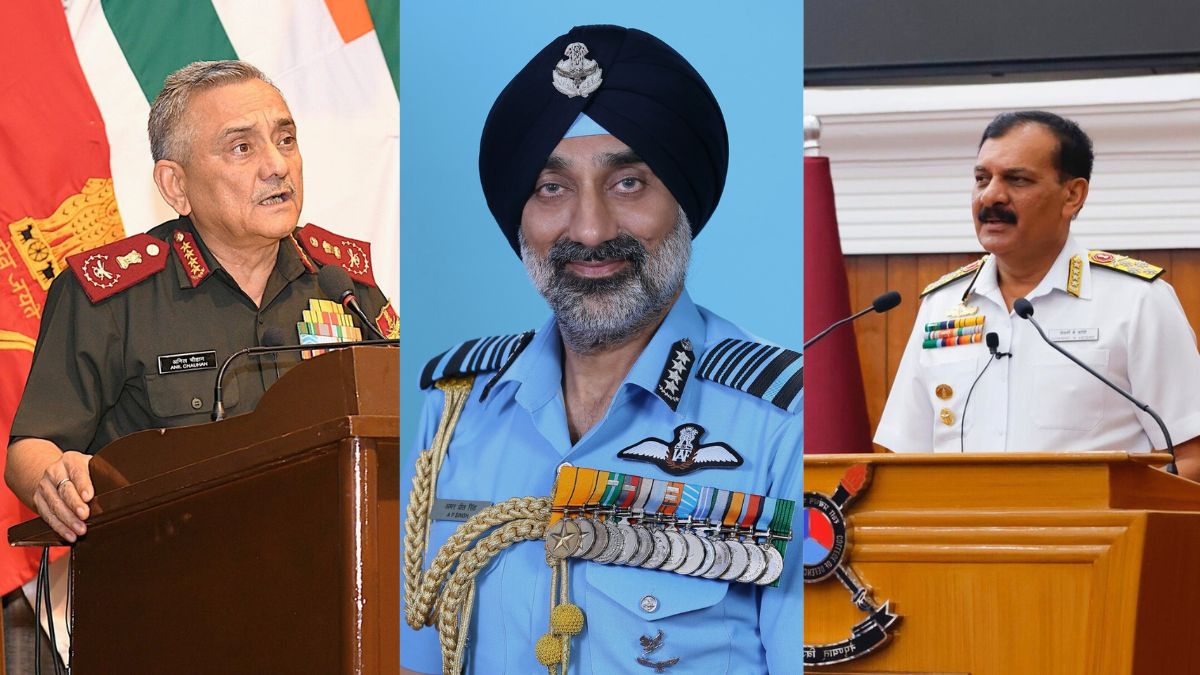At the closing session of the two-day Ran Samwad conclave, Chief of Defence Staff (CDS) General Anil Chauhan addressed what he called “dissonance” within the armed forces over the proposed creation of tri-services theatre commands. His remarks followed a rare public airing of divergent views by the service chiefs Air Chief Marshal AP Singh and Navy Chief Admiral Dinesh Tripathi.
While Air Chief Marshal Singh cautioned against rushing into the process, Navy Chief Admiral Tripathi has backed the integration in principle. Indian military’s theaterisation plans have been under discussion since 2019 and have seen multiple iterations over the last few years.
Theaterisation of military: What sparked the debate?
It all started with Air Chief Marshal Singh on Tuesday (August 26) issuing a word of caution against rushing the rollout of theatre commands. He underlined that India must adopt its own model instead of copying others, while advising that a joint planning and coordination centre be established in Delhi, under the Chiefs of Staff Committee, to prepare for “future wars.”
“I personally feel that having a joint planning and coordination centre in Delhi is what is required,” Singh said, and responding to questions on the proposed theatre commands, he added, “yes, we can start with this first, implement it and see how it pans out. If we need any more structure, we can think about it.”
Day after his remarks, Navy Chief Tripathi shared a divergent view as she iterated that the Indian Navy is committed to synergising its command and control, communications and combat capability with the Army and the Air Force in line with the goal of the theaterisation drive.
Theaterisation: Air Force and Navy’s divergent views?
Speaking at Ran Samvad-2025, the maiden tri-services dialogue on war, warfare and warfighting, held at the Army War College in Dr Ambedkar Nagar, Madhya Pradesh, Admiral Tripathi stressed the need for synergy among the three services. “Another area where significant efforts are being progressed is jointness and integration.”
He stressed that they are committed to synergising command, control, communications and combat capability with the Indian Army and Indian Air Force. Full stop, period. “With theaterisation as the ultimate goal, we are propelling ahead with the goal of unified planning, common picture and integrated operations.”
His views clearly strike a different tone than that of Air Chief Singh’s remarks.
Why are the services divided on Theaterisation?
The Air Chief believes that the armed forces should not come under “any pressure” to roll out theatre commands, underscoring concerns about operational control and resource optimisation. Admiral Tripathi, on the other hand, declared the Navy’s readiness to synchronise command, control, communications, and combat capability with the Army and Air Force.
How did the CDS respond?
CDS Gen Chauhan sought to downplay the differences, presenting them as part of a healthy debate. “There could be a difference among the three services, but we are able to listen to that point,” he said. He described the openness as a sign of maturity, stressing that all disagreements would be resolved in the “best interest of the nation.”
What is the theatre command plan?
First announced by the government in 2019, the theatreisation model seeks to integrate the Army, Navy and Air Force under unified commands, pooling resources for better combat readiness. Each command would cover a geographical theatre, replacing the present system of separate service commands.
The CDS admitted the idea should have been implemented a decade ago, adding, “We are slightly late, but we need to close that gap faster.”
Gen Chauhan acknowledged that retired officers, too, have differing opinions on the plan—often displaying an even stronger urge to defend service turfs. But he insisted that such discussions reflect a “larger desire” to safeguard institutional interests while moving toward jointness.
Theaterisation: Where does the process stand now?
Despite being on the national security agenda since 2019, no tangible progress has been made on rolling out theatre commands. The CDS reassured that integration levels are being reviewed and efforts are underway to “progress things faster.” Yet, the differing service perspectives suggest that the road ahead may still be long.
It is worth mentioning here that the United States is identified as the pioneer of Theaterisation, since it was the first to operationalise Tri-service geographical and functional commands during the second world war.
“Theaterisation implies the amalgamation of all resources required for defending a particular area. If you want to become effective, you need to get all the resources out there. Better results can be achieved if all the resources are deployed under one commander,” former Gen VK Singh had said earlier.
What good can Theaterisation achieve?
CDS Chauhan had in July 2023 explained that the concept of theaterisation is a fundamental change that is on the anvil in the national security realm. He spoke of how it is one of the most ambitious changes with far reaching implications attempted post-independence.
“The start on this journey depends on the right steps being taken first towards jointness and integration. Theaterisation involves creation of tri service theatre specific structures for effective response along the entire spectrum of conflict,” he said, noting that the process would lead to a major change in operations of Indian armed forces.
It will mitigate the major security challenges that India faces in land, sea and space. But transforming the character of the Indian Armed Forces is a complicated task. It requires a lot of time to decide on the allocation of resources, manpower and the structure of the theatre commands. Once theaterisation is fully rolled out, it will be the biggest reform of the Indian Military.
